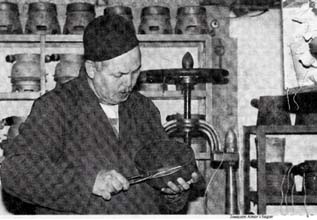The New York Times
March 22, 1995
Fez Journal
Last Refuge of the Tall Tasseled Ottoman Hat
By CHRIS HEDGES
FEZ, Morocco — In the Middle East it still matters what you wear on your head. The
Sudanese have floppy turbans, the Palestinians red and black checkered kafiyehs and the
Saudis the white ghutra. But the maroon, brimless fez, once the epitome of old world
courtesy and taste, has become, for most Muslims politically incorrect.
"It's a hat of the oppressors," said 26-year-old Abdel Jouad. "This is why
no one wears it anymore."
Only the Moroccan royal court has resisted the Muslim world's onslaught against the fez.
King Hassan II is the only Arab leader to wear it. And Cabinet ministers, the royal guard
and the palace staff all favor the fez, although the staff members wear a floppy,
conical-shaped fez that denotes their status.
Any socially ambitious Moroccan man, hoping for an invitation to one of the King's dozen
lavish palaces, would not dare show up bareheaded at the gate. And in the narrow
cobblestone alleys of Fez one can still see men, often in immaculate suits, made a few
inches taller by the bucket-shaped, dark red hat with the black silk tassel.
"In Morocco the fez was seen as a form of protest against the French
occupation," said Chakib Laroussi, the director of the Ministry of Information.
"To put on a fez was to make a statement that one was a nationalist. The fez has, for
generations, been a symbol of the royal palace and part of our national dress."
The origins of the fez, which Moroccans call the tarboosh, Is disputed.
The design may have come from ancient Greece or the Balkans. It gained wide acceptance in
the early 19th century when the Ottoman rulers, who actually never controlled Morocco,
moved to modernize traditional costumes. The brimless hat did not get in the way of a
Muslim's daily prayers and was cleaner, and less cumbersome, than the folds of cloth wound
into a turban. The name fez is believed to come from this city, which once produced the
dye, made from crimson berries, to color the hat.
But the fez fell on hard times after World War I with the dissolution of the Ottoman
Empire. Ataturk outlawed the fez in 1925 as part of his drive to turn Turkey Into a
modern, Westernized state.
Men who wore the hat were imprisoned. The military officers who overthrew the monarchies
in Iraq, Egypt and Libya condemned the fez as a royalist symbol. And Western fashions,
which dropped the bowler and the fedora, left the chic in the Muslim world, like the chic
in Europe, bareheaded.
The decline in the fez's popularity had its effect in Morocco. It is rare to see a young
man, unless he is a member of the court or has dressed for a wedding or a funeral, wearing
a fez. But enough Moroccans still need the hat to keep alive the small fez workshops, with
their wheezing steam ventilators and bronze presses.
The Barrera Brothers Vox workshop, on Mohammed El Hayani Street, occupies three small
rooms with low ceilings behind Fez's main vegetable market.

The company has been producing the fez for the royal court for almost 100 years. Fifty
years ago, at its height, it employed dozens of people in workshops that lined the narrow
Derb al-Barka Street in Fez's old city. Today the company has fewer than a dozen
employees.
The cramped workshop has rows of bronze molds and presses to shape the wool, which is
imported from South Africa and Australia, into the hats.
The workers cut the brim of the fez by hand. One man sews in the leather hatbands on a
machine. And workers lick their fingers to rub off any spots on the finished product
before brushing the fez and wrapping it in white tissue paper.
"We make three grades," said Bachir Berrada, one of the owners. "We make
one for everyday use, one for more formal occasions and one that is worn to Special
events, such as the court. It takes two days to finish a fez."
Hamid Ginoon, wearing a soiled gray work coat, stood over a pyramid-shaped tin cone that
had steam rushing out of dozens of small holes. He was straightening the black silk
tassels over the steam before sewing them by hand on the top of the hats.
"The hardest part is when we place the wool over the inside pile," said Mr.
Ginoon, who has worked here for more than 20 years. "You have to make sure there are
no creases or bubbles between the wool and the lining. Otherwise the fez is ruined."
Amor Abdel Haman, a 57-year-old clerk, sat under the arches of an old stone arcade later
that day, squinting Into the sunlight. He wore a black suit coat, a tie, gray slacks,
polished brown shoes and a fez. "I have worn the fez every day since I was a boy of
12," he said. "It is part of my identity."
When it came time to leave, he stood and bowed slightly, letting his right hand rest
gently on his heart.
"It Is sad, monsieur," he said, "but the fez is dying out, even among my
generation. Dying out like elegance itself."